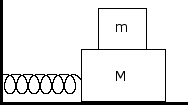Simple Harmonic Motion Example
A block is on a horizontal surface ( a shake table ) that is moving back and forth horizontally with simple harmonic motion of frequency 2.0 Hz. The coefficient of static friction between block and surface is 0.50. How great can the amplitude of the simple harmonic motion be if the block is not to slip along the surface?
SOLUTION MISSING: Unfortunately the author of this youtube video removed their content. You may be able to find a similar problem by checking the other problems in this subject. If you want to contribute, leave a comment with the link to your solution.Related Problems
An oscillator consists of a block attached to a spring( k = 400 N/m). At some time t, the position (measured from the system's equilibrium location), velocity, and acceleration of the block are x = 0.100m, v = -13.6 m/s, and a = -123 m/s . Calculate the
A. frequency of oscillation
B. mass of the block
C. amplitude of the motion
Two blocks (m = 1.8 kg and M = 10 kg) and a spring ( k = 200 N/m ) are arranged on a horizontal frictionless surface. The coefficient of static friction between the two blocks is 0.40. What amplitude of simple harmonic motion of the spring-block system puts the smaller block on the verge of slipping over the larger block?

Find the mechanical energy of a block-spring system having a spring constant of 1.3 N/cm and an oscillation amplitude of 2.4 cm.
A 10 g particle undergoes simple harmonic motion with an amplitude of 2.0 mm, a maximum acceleration of 8 x 10 m/s , and an unknown phase constant. What are
A. the period of the motion?
B. the maximum speed of the particle?
C. the total mechanical energy of the oscillator?
D. the magnitude of the force on the particle at its maximum and half its maximum displacement?